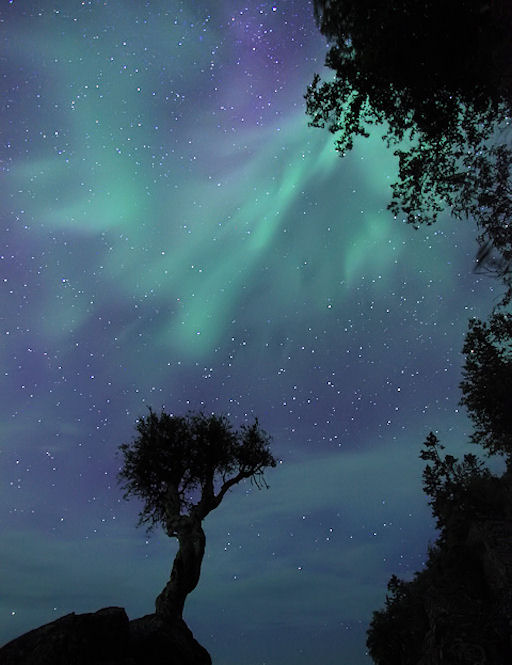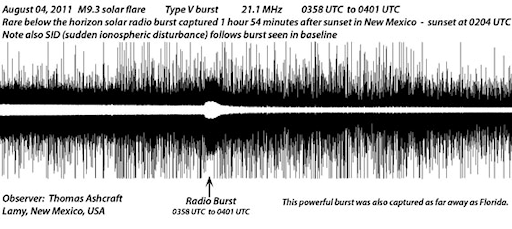Turn your cell phone into a field-tested satellite tracker. Works for Android and iPhone. | | |
SUBSIDING STORM: Earth's magnetic field is still reverberating from a CME strike on August 5th that sparked one of the strongest geomagnetic storms in years. Registering 8 on the 0 to 9 "K-index" scale of magnetic disturbances, the storm at maximum sparked auroras across Europe and in many northern-tier US states. Travis Novitsky sends this picture from Grand Portage, Minnesota:

"For an hour and a half the sky was filled with dancing lights, some of the best I've ever seen in Northern Minnesota!" says Novitsky.
The storm is subsiding now, but it could flare up again as gusty solar wind continues to buffet Earth's magnetic field. High-latitude sky watchers should remain alert for auroras. Aurora alerts: text, voice.
NEW: August 2011 Aurora Gallery
[previous Augusts: 2010, 2009, 2008, 2007, 2006, 2005, 2004, 2003, 2002]
NIGHT-TIME SOLAR RADIO BURST: The M9-class solar flare of August 4th produced a burst of shortwave static so powerful that receivers on Earth picked it up after sunset. "A RadioJove observer in Florida recorded the burst when the sun was 38 degrees below the horizon," reports amateur radio astronomer Thomas Ashcraft. Ashcraft's own radio telescope in New Mexico recorded the event 1 hour and 54 minutes after sunset:

"To my knowledge, receptions like this are very rare," says Ashcraft.
Indeed they are. This event brings to mind the iconic night-time solar radio burst of March 8, 1958. Five radio telescopes at the University of Florida picked up emissions from the sun while observing the planet Jupiter in tthe middle of the night. On the other side of the world, radio astronomers in daylit Australia confirmed that a powerful solar radio burst had taken place at that exact time. The event is described in a 1959 Nature paper by pioneering radio astronomers Alex Smith and Tom Carr. They considered the possibility that solar radio waves might have been reflected by the Moon or carried to the night side of Earth by ionospheric ducting. In tthe end, they could not conclusively explain what happened and to this day night-time solar radio bursts remain a puzzle.
2011 Noctilucent Cloud Gallery
[previous years: 2003, 2004, 2005, 2006, 2007, 2008, 2009]
Potentially Hazardous Asteroids (
PHAs) are space rocks larger than approximately 100m that can come closer to Earth than 0.05 AU. None of the known PHAs is on a collision course with our planet, although astronomers are finding
new ones all the time.
On August 6, 2011 there were 1241 potentially hazardous asteroids.
Notes: LD means "Lunar Distance." 1 LD = 384,401 km, the distance between Earth and the Moon. 1 LD also equals 0.00256 AU. MAG is the visual magnitude of the asteroid on the date of closest approach. | | The official U.S. government space weather bureau |
| | The first place to look for information about sundogs, pillars, rainbows and related phenomena. |
| | Researchers call it a "Hubble for the sun." SDO is the most advanced solar observatory ever. |
| | 3D views of the sun from NASA's Solar and Terrestrial Relations Observatory |
| | Realtime and archival images of the Sun from SOHO. |
| | from the NOAA Space Environment Center |
| | the underlying science of space weather |
| | for out-of-this-world printing and graphics |

